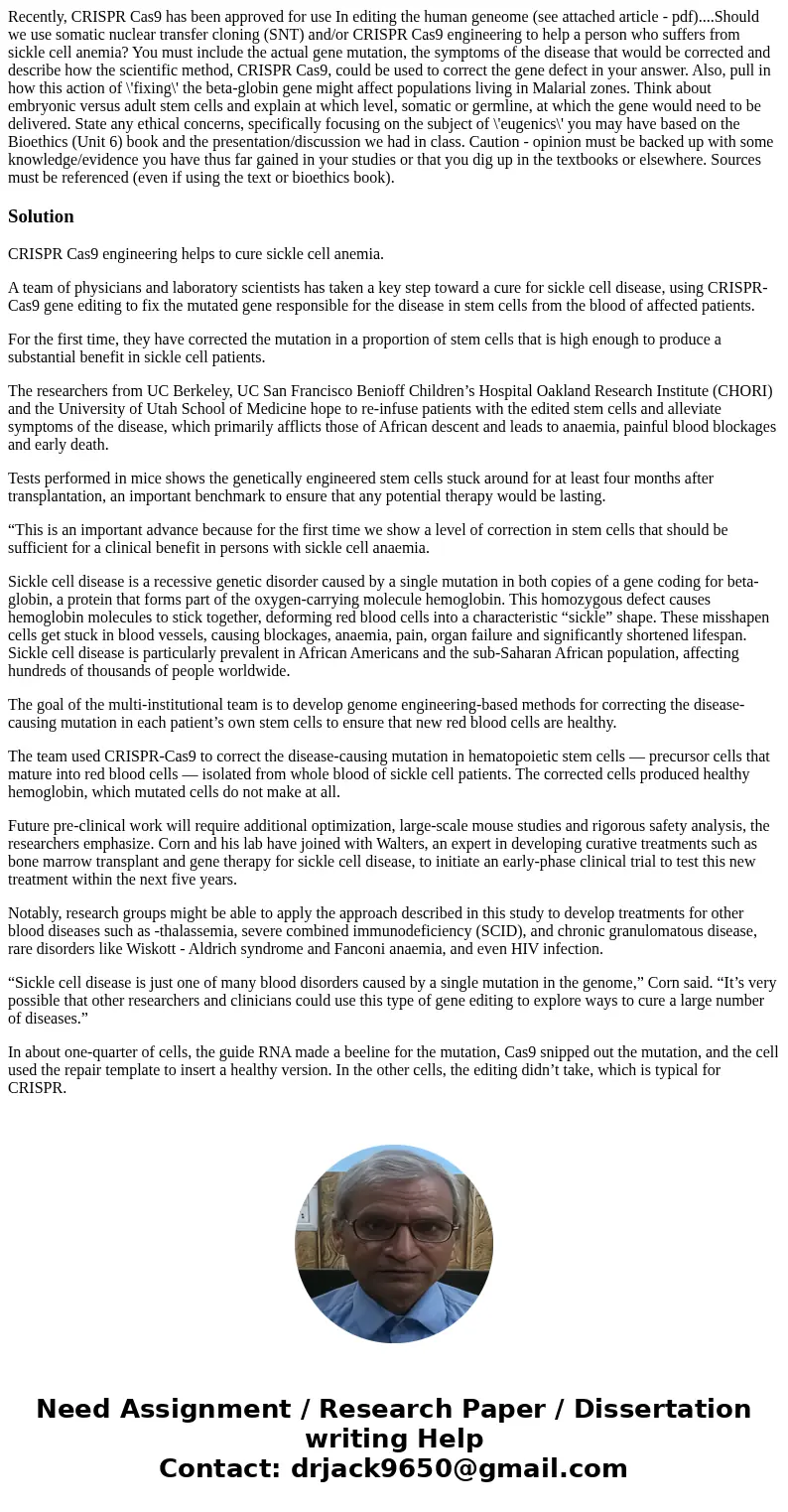Recently CRISPR Cas9 has been approved for use In editing th
Solution
CRISPR Cas9 engineering helps to cure sickle cell anemia.
A team of physicians and laboratory scientists has taken a key step toward a cure for sickle cell disease, using CRISPR-Cas9 gene editing to fix the mutated gene responsible for the disease in stem cells from the blood of affected patients.
For the first time, they have corrected the mutation in a proportion of stem cells that is high enough to produce a substantial benefit in sickle cell patients.
The researchers from UC Berkeley, UC San Francisco Benioff Children’s Hospital Oakland Research Institute (CHORI) and the University of Utah School of Medicine hope to re-infuse patients with the edited stem cells and alleviate symptoms of the disease, which primarily afflicts those of African descent and leads to anaemia, painful blood blockages and early death.
Tests performed in mice shows the genetically engineered stem cells stuck around for at least four months after transplantation, an important benchmark to ensure that any potential therapy would be lasting.
“This is an important advance because for the first time we show a level of correction in stem cells that should be sufficient for a clinical benefit in persons with sickle cell anaemia.
Sickle cell disease is a recessive genetic disorder caused by a single mutation in both copies of a gene coding for beta-globin, a protein that forms part of the oxygen-carrying molecule hemoglobin. This homozygous defect causes hemoglobin molecules to stick together, deforming red blood cells into a characteristic “sickle” shape. These misshapen cells get stuck in blood vessels, causing blockages, anaemia, pain, organ failure and significantly shortened lifespan. Sickle cell disease is particularly prevalent in African Americans and the sub-Saharan African population, affecting hundreds of thousands of people worldwide.
The goal of the multi-institutional team is to develop genome engineering-based methods for correcting the disease-causing mutation in each patient’s own stem cells to ensure that new red blood cells are healthy.
The team used CRISPR-Cas9 to correct the disease-causing mutation in hematopoietic stem cells — precursor cells that mature into red blood cells — isolated from whole blood of sickle cell patients. The corrected cells produced healthy hemoglobin, which mutated cells do not make at all.
Future pre-clinical work will require additional optimization, large-scale mouse studies and rigorous safety analysis, the researchers emphasize. Corn and his lab have joined with Walters, an expert in developing curative treatments such as bone marrow transplant and gene therapy for sickle cell disease, to initiate an early-phase clinical trial to test this new treatment within the next five years.
Notably, research groups might be able to apply the approach described in this study to develop treatments for other blood diseases such as -thalassemia, severe combined immunodeficiency (SCID), and chronic granulomatous disease, rare disorders like Wiskott - Aldrich syndrome and Fanconi anaemia, and even HIV infection.
“Sickle cell disease is just one of many blood disorders caused by a single mutation in the genome,” Corn said. “It’s very possible that other researchers and clinicians could use this type of gene editing to explore ways to cure a large number of diseases.”
In about one-quarter of cells, the guide RNA made a beeline for the mutation, Cas9 snipped out the mutation, and the cell used the repair template to insert a healthy version. In the other cells, the editing didn’t take, which is typical for CRISPR.
When the CRISPR cells were transplanted into the bone marrow of seven mice, 2 percent to 6 percent of the cells retained the CRISPR hemoglobin for all 16 weeks of the study. (The range reflects the fact that, among other things, some patients’ cells were easier to CRISPR than others’, for unknown reasons.) A few percent might seem low, said Jacob Corn, scientific director of the Innovative Genomics Initiative and a co-leader of the study, but studies suggest that having just 2 percent to 5 percent of healthy red blood cells could be enough to cure sickle cell.


 Homework Sourse
Homework Sourse